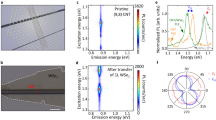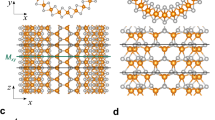Abstract
Although metallic nanostructures are useful for nanoscale optics, all of their key optical properties are determined by their geometry. This makes it difficult to adjust these properties independently, and can restrict applications. Here we use the absolute intensity of Rayleigh scattering to show that single-walled carbon nanotubes can form ideal optical wires. The spatial distribution of the radiation scattered by the nanotubes is determined by their shape, but the intensity and spectrum of the scattered radiation are determined by exciton dynamics, quantum-dot-like optical resonances and other intrinsic properties. Moreover, the nanotubes display a uniform peak optical conductivity of ∼8 e2/h, which we derive using an exciton model, suggesting universal behaviour similar to that observed in nanotube conductance. We further demonstrate a radiative coupling between two distant nanotubes, with potential applications in metamaterials and optical antennas.
This is a preview of subscription content, access via your institution
Access options
Subscribe to this journal
Receive 12 print issues and online access
$259.00 per year
only $21.58 per issue
Buy this article
- Purchase on Springer Link
- Instant access to full article PDF
Prices may be subject to local taxes which are calculated during checkout




Similar content being viewed by others
References
Bharadwaj, P., Deutsch, B. & Novotny, L. Optical antennas. Adv. Opt. Photon. 1, 438–483 (2009).
Schuck, P. J., Fromm, D. P., Sundaramurthy, A., Kino, G. S. & Moerner, W. E. Improving the mismatch between light and nanoscale objects with gold bowtie nanoantennas. Phys. Rev. Lett. 94, 017402 (2005).
Muhlschlegel, P., Eisler, H. J., Martin, O. J. F., Hecht, B. & Pohl, D. W. Resonant optical antennas. Science 308, 1607–1609 (2005).
Farahani, J. N., Pohl, D. W., Eisler, H. J. & Hecht, B. Single quantum dot coupled to a scanning optical antenna: a tunable superemitter. Phys. Rev. Lett. 95, 017402 (2005).
Alu, A. & Engheta, N. Tuning the scattering response of optical nanoantennas with nanocircuit loads. Nature Photon. 2, 307–310 (2008).
Taminiau, T. H., Stefani, F. D., Segerink, F. B. & Van Hulst, N. F. Optical antennas direct single-molecule emission. Nature Photon. 2, 234–237 (2008).
Kelly, K. L., Coronado, E., Zhao, L. L. & Schatz, G. C. The optical properties of metal nanoparticles: the influence of size, shape, and dielectric environment. J. Phys. Chem. B 107, 668–677 (2003).
Slepyan, G. Y., Shuba, M. V., Maksimenko, S. A. & Lakhtakia, A. Theory of optical scattering by achiral carbon nanotubes and their potential as optical nanoantennas. Phys. Rev. B 73, 195416 (2006).
Wang, F., Dukovic, G., Brus, L. E. & Heinz, T. F. The optical resonances in carbon nanotubes arise from excitons. Science 308, 838–841 (2005).
Sfeir, M. et al. Probing electronic transitions in individual carbon nanotubes by Rayleigh scattering. Science 306, 1540–1543 (2004).
Sfeir, M. et al. Optical spectroscopy of individual single-walled carbon nanotubes of defined chiral structure. Science 312, 554–556 (2006).
Bachilo, S. et al. Structure-assigned optical spectra of single-walled carbon nanotubes. Science 298, 2361–2366 (2002).
Berciaud, S. et al. Excitons and high-order optical transitions in individual carbon nanotubes: a Rayleigh scattering spectroscopy study. Phys. Rev. B 81, 041414 (2010).
Dresselhaus, M., Dresselhaus, G., Saito, R. & Jorio, A. Raman spectroscopy of carbon nanotubes. Phys. Rep. 409, 47–99 (2005).
Dresselhaus, M. S., Dresselhaus, G., Saito, R. & Jorio, A. Exciton photophysics of carbon nanotubes. Annu. Rev. Phys. Chem. 58, 719–747 (2007).
Ando, T. Excitons in carbon nanotubes. J. Phys. Soc. Jpn 66, 1066–1073 (1997).
Kane, C. L. & Mele, E. J. Ratio problem in single carbon nanotube fluorescence spectroscopy. Phys. Rev. Lett. 90, 207401 (2003).
Spataru, C. D., Ismail-Beigi, S., Benedict, L. X. & Louie, S. G. Quasiparticle energies, excitonic effects and optical absorption spectra of small-diameter single-walled carbon nanotubes. Appl. Phys. A 78, 1129–1136 (2004).
Jackson, J. D. Classical Electrodynamics 3rd edn (Wiley, 1998).
Slepyan, G. Y., Maksimenko, S. A., Lakhtakia, A., Yevtushenko, O. & Gusakov, A. V. Electrodynamics of carbon nanotubes: dynamic conductivity, impedance boundary conditions, and surface wave propagation. Phys. Rev. B 60, 17136–17149 (1999).
Burke, P. J., Li, S. D. & Yu, Z. Quantitative theory of nanowire and nanotube antenna performance. IEEE Trans. Nanotechnol. 5, 314–334 (2006).
Hanson, G. W. Fundamental transmitting properties of carbon nanotube antennas. IEEE Trans. Antenn. Propag. 53, 3426–3435 (2005).
Hao, J. & Hanson, G. W. Infrared and optical properties of carbon nanotube dipole antennas. IEEE Trans. Nanotechnol. 5, 766–775 (2006).
Kempa, K. et al. Carbon nanotubes as optical antennae. Adv. Mater. 19, 421–426 (2007).
Wang, Y. et al. Receiving and transmitting light-like radio waves: antenna effect in arrays of aligned carbon nanotubes. Appl. Phys. Lett. 85, 2607–2609 (2004).
Cubukcu, E. et al. Aligned carbon nanotubes as polarization-sensitive, molecular near-field detectors. Proc. Natl Acad. Sci. USA 106, 2495–2499 (2009).
Joh, D. et al. On-chip Rayleigh imaging and spectroscopy of carbon nanotubes. Nano Lett. doi:10.1021/nl1012568 (2010).
Bohren, C. & Huffman, D. Absorption and Scattering of Light by Small Particles (Wiley, 1998).
Abbott, T. A. & Griffiths, D. J. Acceleration without radiation. Am. J. Phys. 53, 1203–1211 (1985).
Perebeinos, V., Tersoff, J. & Avouris, P. Scaling of excitons in carbon nanotubes. Phys. Rev. Lett. 92, 257402 (2004).
Spataru, C. D., Ismail-Beigi, S., Capaz, R. B. & Louie, S. G. Theory and ab initio calculation of radiative lifetime of excitons in semiconducting carbon nanotubes. Phys. Rev. Lett. 95, 247402 (2005).
Manzoni, C. et al. Intersubband exciton relaxation dynamics in single-walled carbon nanotubes. Phys. Rev. Lett. 94, 207401 (2005).
Berciaud, S., Cognet, L. & Lounis, B. Luminescence decay and the absorption cross section of individual single-walled carbon nanotubes. Phys. Rev. Lett. 101, 077402 (2008).
Scholes, G. D. Long-range resonance energy transfer in molecular systems. Annu. Rev. Phys. Chem. 54, 57–87 (2003).
Wang, F. et al. Interactions between individual carbon nanotubes studied by Rayleigh scattering spectroscopy. Phys. Rev. Lett. 96, 167401 (2006).
Ju, S. Y., Kopcha, W. P. & Papadimitrakopoulos, F. Brightly fluorescent single-walled carbon nanotubes via an oxygen-excluding surfactant organization. Science 323, 1319–1323 (2009).
Tan, P. H. et al. Photoluminescence spectroscopy of carbon nanotube bundles: evidence for exciton energy transfer. Phys. Rev. Lett. 99, 137402 (2007).
Acknowledgements
The authors thank P.L. McEuen for useful discussions, and Y.J. Kim and R. Havener for assistance with sample fabrication and numerical modelling. This work was supported by the National Science Foundation (NSF) through the Center for Nanoscale Systems, Cornell Center for Materials Research, Center for Chemical Innovation and an NSF CAREER grant. Additional funding was received from the David and Lucile Packard Foundation, Alfred P. Sloan Foundation, Camille and Henry Dreyfus Foundation, and the US Department of Defense through the Air Force Office of Scientific Research. Sample fabrication was performed at the Cornell Nanoscale Science and Technology Facility, a National Nanotechnology Infrastructure Network node.
Author information
Authors and Affiliations
Contributions
D.J. and L.H. performed optical measurements and analysed the data. J.K. carried out theoretical calculations. S.-Y.J. and J.J. performed Raman spectroscopy measurements. M.S. carried out nanotube synthesis. G.C. and J.P. supervised the project.
Corresponding author
Ethics declarations
Competing interests
The authors declare no competing financial interests.
Supplementary information
Supplementary information
Supplementary information (PDF 1060 kb)
Rights and permissions
About this article
Cite this article
Joh, D., Kinder, J., Herman, L. et al. Single-walled carbon nanotubes as excitonic optical wires. Nature Nanotech 6, 51–56 (2011). https://doi.org/10.1038/nnano.2010.248
Received:
Accepted:
Published:
Issue Date:
DOI: https://doi.org/10.1038/nnano.2010.248
This article is cited by
-
Influence of nano and bulk copper on agile frog development
Ecotoxicology (2022)
-
6 nm super-resolution optical transmission and scattering spectroscopic imaging of carbon nanotubes using a nanometer-scale white light source
Nature Communications (2021)
-
Real-time vibrations of a carbon nanotube
Nature (2019)
-
Size-Dependent Neurotoxicity of Aluminum Oxide Particles: a Comparison Between Nano- and Micrometer Size on the Basis of Mitochondrial Oxidative Damage
Biological Trace Element Research (2018)
-
Oxidative damage to Pseudomonas aeruginosa ATCC 27833 and Staphylococcus aureus ATCC 24213 induced by CuO-NPs
Environmental Science and Pollution Research (2017)



